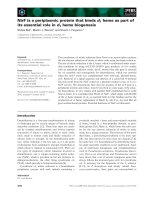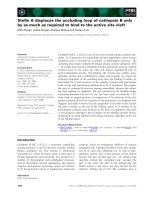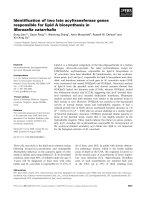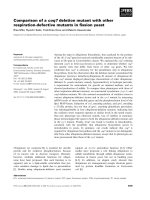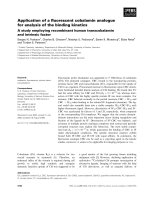Báo cáo khoa học: "Jointly optimizing a two-step conditional random field model for machine transliteration and its fast decoding algorithm" pdf
Bạn đang xem bản rút gọn của tài liệu. Xem và tải ngay bản đầy đủ của tài liệu tại đây (134.61 KB, 6 trang )
Proceedings of the ACL 2010 Conference Short Papers, pages 275–280,
Uppsala, Sweden, 11-16 July 2010.
c
2010 Association for Computational Linguistics
Jointly optimizing a two-step conditional random field model for machine
transliteration and its fast decoding algorithm
Dong Yang, Paul Dixon and Sadaoki Furui
Department of Computer Science
Tokyo Institute of Technology
Tokyo 152-8552 Japan
{raymond,dixonp,furui}@furui.cs.titech.ac.jp
Abstract
This paper presents a joint optimization
method of a two-step conditional random
field (CRF) model for machine transliter-
ation and a fast decoding algorithm for
the proposed method. Our method lies in
the category of direct orthographical map-
ping (DOM) between two languages with-
out using any intermediate phonemic map-
ping. In the two-step CRF model, the first
CRF segments an input word into chunks
and the second one converts each chunk
into one unit in the target language. In this
paper, we propose a method to jointly op-
timize the two-step CRFs and also a fast
algorithm to realize it. Our experiments
show that the proposed method outper-
forms the well-known joint source channel
model (JSCM) and our proposed fast al-
gorithm decreases the decoding time sig-
nificantly. Furthermore, combination of
the proposed method and the JSCM gives
further improvement, which outperforms
state-of-the-art results in terms of top-1 ac-
curacy.
1 Introduction
There are more than 6000 languages in the world
and 10 languages of them have more than 100 mil-
lion native speakers. With the information revolu-
tion and globalization, systems that support mul-
tiple language processing and spoken language
translation become urgent demands. The transla-
tion of named entities from alphabetic to syllabary
language is usually performed through translitera-
tion, which tries to preserve the pronunciation in
the original language.
For example, in Chinese, foreign words are
written with Chinese characters; in Japanese, for-
eign words are usually written with special char-
G o o g l e 䉫䊷 䉫 䊦 English-to-Japanese
G o o g l e
䈋 ℠ English-to-Chinese
Source Name Target Name Note
gu ge Chinese Romanized writing
guu gu ru Japanese Romanized writing
Figure 1: Transliteration examples
acters called Katakana; examples are given in Fig-
ure 1.
An intuitive transliteration method (Knight and
Graehl, 1998; Oh et al., 2006) is to firstly convert
a source word into phonemes, then find the corre-
sponding phonemes in the target language, and fi-
nally convert them to the target language’s written
system. There are two reasons why this method
does not work well: first, the named entities have
diverse origins and this makes the grapheme-to-
phoneme conversion very difficult; second, the
transliteration is usually not only determined by
the pronunciation, but also affected by how they
are written in the original language.
Direct orthographical mapping (DOM), which
performs the transliteration between two lan-
guages directly without using any intermediate
phonemic mapping, is recently gaining more at-
tention in the transliteration research community,
and it is also the “Standard Run” of the “NEWS
2009 Machine Transliteration Shared Task” (Li et
al., 2009). In this paper, we try to make our system
satisfy the standard evaluation condition, which
requires that the system uses the provided parallel
corpus (without pronunciation) only, and cannot
use any other bilingual or monolingual resources.
The source channel and joint source channel
models (JSCMs) (Li et al., 2004) have been pro-
posed for DOM, which try to model P (T |S) and
P (T, S) respectively, where T and S denote the
words in the target and source languages. Ekbal
et al. (2006) modified the JSCM to incorporate
different context information into the model for
275
Indian languages. In the “NEWS 2009 Machine
Transliteration Shared Task”, a new two-step CRF
model for transliteration task has been proposed
(Yang et al., 2009), in which the first step is to
segment a word in the source language into char-
acter chunks and the second step is to perform a
context-dependent mapping from each chunk into
one written unit in the target language.
In this paper, we propose to jointly optimize a
two-step CRF model. We also propose a fast de-
coding algorithm to speed up the joint search. The
rest of this paper is organized as follows: Sec-
tion 2 explains the two-step CRF method, fol-
lowed by Section 3 which describes our joint opti-
mization method and its fast decoding algorithm;
Section 4 introduces a rapid implementation of a
JSCM system in the weighted finite state trans-
ducer (WFST) framework; and the last section
reports the experimental results and conclusions.
Although our method is language independent, we
use an English-to-Chinese transliteration task in
all the explanations and experiments.
2 Two-step CRF method
2.1 CRF introduction
A chain-CRF (Lafferty et al., 2001) is an undi-
rected graphical model which assigns a probability
to a label sequence L = l
1
l
2
. . . l
T
, given an input
sequence C = c
1
c
2
. . . c
T
. CRF training is usually
performed through the L-BFGS algorithm (Wal-
lach, 2002) and decoding is performed by the
Viterbi algorithm. We formalize machine translit-
eration as a CRF tagging problem, as shown in
Figure 2.
T i m o t h y 㩖 㥿 㽓
T/B i/N m/B o/N t/B h/N y/N
Ti/㩖 mo/㥿 thy/㽓
Figure 2: An pictorial description of a CRF seg-
menter and a CRF converter
2.2 CRF segmenter
In the CRF, a feature function describes a co-
occurrence relation, and it is usually a binary func-
tion, taking the value 1 when both an observa-
tion and a label transition are observed. Yang et
al. (2009) used the following features in the seg-
mentation tool:
• Single unit features: C
−2
, C
−1
, C
0
, C
1
, C
2
• Combination features: C
−1
C
0
, C
0
C
1
Here, C
0
is the current character, C
−1
and C
1
de-
note the previous and next characters, and C
−2
and
C
2
are the characters located two positions to the
left and right of C
0
.
One limitation of their work is that only top-1
segmentation is output to the following CRF con-
verter.
2.3 CRF converter
Similar to the CRF segmenter, the CRF converter
has the format shown in Figure 2.
For this CRF, Yang et al. (2009) used the fol-
lowing features:
• Single unit features: CK
−1
, CK
0
, CK
1
• Combination features: CK
−1
CK
0
,
CK
0
CK
1
where CK represents the source language chunk,
and the subscript notation is the same as the CRF
segmenter.
3 Joint optimization and its fast decoding
algorithm
3.1 Joint optimization
We denote a word in the source language by S, a
segmentation of S by A, and a word in the target
langauge by T . Our goal is to find the best word
ˆ
T
in the target language which maximizes the prob-
ability P (T |S).
Yang et al. (2009) used only the best segmen-
tation in the first CRF and the best output in the
second CRF, which is equivalent to
ˆ
A = arg max
A
P (A|S)
ˆ
T = arg max
T
P (T |S,
ˆ
A), (1)
where P (A|S) and P (T |S, A) represent two
CRFs respectively. This method considers the seg-
mentation and the conversion as two independent
steps. A major limitation is that, if the segmenta-
tion from the first step is wrong, the error propa-
gates to the second step, and the error is very dif-
ficult to recover.
In this paper, we propose a new method to
jointly optimize the two-step CRF, which can be
276
written as:
ˆ
T = arg max
T
P (T |S)
= arg max
T
A
P (T, A|S)
= arg max
T
A
P (A|S)P (T |S, A)
(2)
The joint optimization considers all the segmen-
tation possibilities and sums the probability over
all the alternative segmentations which generate
the same output. It considers the segmentation and
conversion in a unified framework and is robust to
segmentation errors.
3.2 N-best approximation
In the process of finding the best output using
Equation 2, a dynamic programming algorithm for
joint decoding of the segmentation and conversion
is possible, but the implementation becomes very
complicated. Another direction is to divide the de-
coding into two steps of segmentation and conver-
sion, which is this paper’s method. However, exact
inference by listing all possible candidates explic-
itly and summing over all possible segmentations
is intractable, because of the exponential computa-
tion complexity with the source word’s increasing
length.
In the segmentation step, the number of possible
segmentations is 2
N
, where N is the length of the
source word and 2 is the size of the tagging set. In
the conversion step, the number of possible candi-
dates is M
N
′
, where N
′
is the number of chunks
from the 1st step and M is the size of the tagging
set. M is usually large, e.g., about 400 in Chinese
and 50 in Japanese, and it is impossible to list all
the candidates.
Our analysis shows that beyond the 10th candi-
date, almost all the probabilities of the candidates
in both steps drop below 0.01. Therefore we de-
cided to generate top-10 results for both steps to
approximate the Equation 2.
3.3 Fast decoding algorithm
As introduced in the previous subsection, in the
whole decoding process we have to perform n-best
CRF decoding in the segmentation step and 10 n-
best CRF decoding in the second CRF. Is it really
necessary to perform the second CRF for all the
segmentations? The answer is “No” for candidates
with low probabilities. Here we propose a no-loss
fast decoding algorithm for deciding when to stop
performing the second CRF decoding.
Suppose we have a list of segmentation candi-
dates which are generated by the 1st CRF, ranked
by probabilities P (A|S) in descending order A :
A
1
, A
2
, , A
N
and we are performing the 2nd
CRF decoding starting from A
1
. Up to A
k
,
we get a list of candidates T : T
1
, T
2
, , T
L
,
ranked by probabilities in descending order. If
we can guarantee that, even performing the 2nd
CRF decoding for all the remaining segmentations
A
k+1
, A
k+2
, , A
N
, the top 1 candidate does not
change, then we can stop decoding.
We can show that the following formula is the
stop condition:
P
k
(T
1
|S) − P
k
(T
2
|S) > 1 −
k
j=1
P (A
j
|S). (3)
The meaning of this formula is that the prob-
ability of all the remaining candidates is smaller
than the probability difference between the best
and the second best candidates; on the other hand,
even if all the remaining probabilities are added to
the second best candidate, it still cannot overturn
the top candidate. The mathematical proof is pro-
vided in Appendix A.
The stop condition here has no approximation
nor pre-defined assumption, and it is a no-loss fast
decoding algorithm.
4 Rapid development of a JSCM system
The JSCM represents how the source words and
target names are generated simultaneously (Li et
al., 2004):
P (S, T ) = P (s
1
, s
2
, , s
k
, t
1
, t
2
, , t
k
)
= P (< s, t >
1
, < s, t >
2
, , < s, t >
k
)
=
K
k=1
P (< s , t >
k
| < s, t >
k−1
1
) (4)
where S = (s
1
, s
2
, , s
k
) is a word in the source
langauge and T = (t
1
, t
2
, , t
k
) is a word in the
target language.
The training parallel data without alignment is
first aligned by a Viterbi version EM algorithm (Li
et al., 2004).
The decoding problem in JSCM can be written
as:
ˆ
T = arg max
T
P (S, T ). (5)
277
After the alignments are generated, we use the
MITLM toolkit (Hsu and Glass, 2008) to build a
trigram model with modified Kneser-Ney smooth-
ing. We then convert the n-gram to a WFST
M (Sproat et al., 2000; Caseiro et al., 2002). To al-
low transliteration from a sequence of characters,
a second WFST T is constructed. The input word
is converted to an acceptor I, and it is then com-
bined with T and M according to O = I ◦ T ◦ M
where ◦ denotes the composition operator. The
n–best paths are extracted by projecting the out-
put, removing the epsilon labels and applying the
n-shortest paths algorithm with determinization in
the OpenFst Toolkit (Allauzen et al., 2007).
5 Experiments
We use several metrics from (Li et al., 2009) to
measure the performance of our system.
1. Top-1 ACC: word accuracy of the top-1 can-
didate
2. Mean F-score: fuzziness in the top-1 candi-
date, how close the top-1 candidate is to the refer-
ence
3. MRR: mean reciprocal rank, 1/MRR tells ap-
proximately the average rank of the correct result
5.1 Comparison with the baseline and JSCM
We use the training, development and test sets of
NEWS 2009 data for English-to-Chinese in our
experiments as detailed in Table 1. This is a paral-
lel corpus without alignment.
Training data Development data Test data
31961 2896 2896
Table 1: Corpus size (number of word pairs)
We compare the proposed decoding method
with the baseline which uses only the best candi-
dates in both CRF steps, and also with the well
known JSCM. As we can see in Table 2, the pro-
posed method improves the baseline top-1 ACC
from 0.670 to 0.708, and it works as well as, or
even better than the well known JSCM in all the
three measurements.
Our experiments also show that the decoding
time can be reduced significantly via using our fast
decoding algorithm. As we have explained, with-
out fast decoding, we need 11 CRF n-best decod-
ing for each word; the number can be reduced to
3.53 (1 “the first CRF”+2.53 “the second CRF”)
via the fast decoding algorithm.
We should notice that the decoding time is sig-
nificantly shorter than the training time. While
testing takes minutes on a normal PC, the train-
ing of the CRF converter takes up to 13 hours on
an 8-core (8*3G Hz) server.
Measure Top-1 Mean MRR
ACC F-score
Baseline 0.670 0.869 0.750
Joint optimization 0.708 0.885 0.789
JSCM 0.706 0.882 0.789
Table 2: Comparison of the proposed decoding
method with the previous method and the JSCM
5.2 Further improvement
We tried to combine the two-step CRF model and
the JSCM. From the two-step CRF model we get
the conditional probability P
CRF
(T |S) and from
the JSCM we get the joint probability P (S, T ).
The conditional probability of P
JSCM
(T |S) can
be calculuated as follows:
P
JSCM
(T |S) =
P (T, S)
P (S)
=
P (T, S)
T
P (T, S)
. (6)
They are used in our combination method as:
P (T |S) = λP
CRF
(T |S) + (1 − λ)P
JSCM
(T |S)
(7)
where λ denotes the interpolation weight (λ is set
by development data in this paper).
As we can see in Table 3, the linear combination
of two sytems further improves the top-1 ACC to
0.720, and it has outperformed the best reported
“Standard Run” (Li et al., 2009) result 0.717. (The
reported best “Standard Run” result 0.731 used
target language phoneme information, which re-
quires a monolingual dictionary; as a result it is
not a standard run.)
Measure Top-1 Mean MRR
ACC F-score
Baseline+JSCM 0.713 0.883 0.794
Joint optimization
+ JSCM 0.720 0.888 0.797
state-of-the-art 0.717 0.890 0.785
(Li et al., 2009)
Table 3: Model combination results
6 Conclusions and future work
In this paper we have presented our new joint
optimization method for a two-step CRF model
and its fast decoding algorithm. The proposed
278
method improved the system significantly and out-
performed the JSCM. Combining the proposed
method with JSCM, the performance was further
improved.
In future work we are planning to combine our
system with multilingual systems. Also we want
to make use of acoustic information in machine
transliteration. We are currently investigating dis-
criminative training as a method to further im-
prove the JSCM. Another issue of our two-step
CRF method is that the training complexity in-
creases quadratically according to the size of the
label set, and how to reduce the training time needs
more research.
Appendix A. Proof of Equation 3
The CRF segmentation provides a list of segmen-
tations: A : A
1
, A
2
, , A
N
, with conditional
probabilities P (A
1
|S), P(A
2
|S), , P (A
N
|S).
N
j=1
P (A
j
|S) = 1.
The CRF conversion, given a segmenta-
tion A
i
, provides a list of transliteration out-
put T
1
, T
2
, , T
M
, with conditional probabilities
P (T
1
|S, A
i
), P (T
2
|S, A
i
), , P (T
M
|S, A
i
).
In our fast decoding algorithm, we start per-
forming the CRF conversion from A
1
, then A
2
,
and then A
3
, etc. Up to A
k
, we get a list of can-
didates T : T
1
, T
2
, , T
L
, ranked by probabili-
ties P
k
(T |S) in descending order. The probability
P
k
(T
l
|S)(l = 1, 2, , L) is accumulated probabil-
ity of P (T
l
|S) over A
1
, A
2
, , A
k
, calculated by:
P
k
(T
l
|S) =
k
j=1
P (A
j
|S)P (T
l
|S, A
j
)
If we continue performing the CRF conversion
to cover all N (N ≥ k) segmentations, eventually
we will get:
P (T
l
|S) =
N
j=1
P (A
j
|S)P (T
l
|S, A
j
)
≥
k
j=1
P (A
j
|S)P (T
l
|S, A
j
)
= P
k
(T
l
|S) (8)
If Equation 3 holds, then for ∀i = 1,
P
k
(T
1
|S) > P
k
(T
2
|S) + (1 −
k
j=1
P (A
j
|S))
≥ P
k
(T
i
|S) + (1 −
k
j=1
P (A
j
|S))
= P
k
(T
i
|S) +
N
j=k+1
P (A
j
|S)
≥ P
k
(T
i
|S)
+
N
j=k+1
P (A
j
|S)P (T
i
|S, A
j
)
= P (T
i
|S) (9)
Therefore, P (T
1
|S) > P (T
i
|S)(i = 1), and T
1
maximizes the probability P (T |S).
279
References
Cyril Allauzen, Michael Riley, Johan Schalkwyk, Wo-
jciech Skut and Mehryar Mohri 2007. OpenFst: A
General and Efficient Weighted Finite-State Trans-
ducer Library. Proceedings of the Ninth Interna-
tional Conference on Implementation and Applica-
tion of Automata, (CIAA), pages 11-23.
Diamantino Caseiro, Isabel Trancosoo, Luis Oliveira
and Ceu Viana 2002. Grapheme-to-phone using fi-
nite state transducers. Proceedings IEEE Workshop
on Speech Synthesis.
Asif Ekbal, Sudip Kumar Naskar and Sivaji Bandy-
opadhyay. 2006. A modified joint source-channel
model for transliteration, Proceedings of the COL-
ING/ACL, pages 191-198.
Bo-June Hsu and James Glass 2008. Iterative Lan-
guage Model Estimation: Efficient Data Structure
& Algorithms. Proceedings Interspeech, pages 841-
844.
Kevin Knight and Jonathan Graehl. 1998. Machine
Transliteration, Association for Computational Lin-
guistics.
John Lafferty, Andrew McCallum, and Fernando
Pereira 2001. Conditional Random Fields: Prob-
abilistic Models for Segmenting and Labeling Se-
quence Data., Proceedings of International Confer-
ence on Machine Learning, pages 282-289.
Haizhou Li, Min Zhang and Jian Su. 2004. A joint
source-channel model for machine transliteration,
Proceedings of the 42nd Annual Meeting on Asso-
ciation for Computational Linguistics.
Haizhou Li, A. Kumaran, Vladimir Pervouchine and
Min Zhang 2009. Report of NEWS 2009 Ma-
chine Transliteration Shared Task, Proceedings of
the 2009 Named Entities Workshop: Shared Task on
Transliteration (NEWS 2009), pages 1-18
Jong-Hoon Oh, Key-Sun Choi and Hitoshi Isahara.
2006. A comparison of different machine transliter-
ation models , Journal of Artificial Intelligence Re-
search, 27, pages 119-151.
Richard Sproat 2000. Corpus-Based Methods and
Hand-Built Methods. Proceedings of International
Conference on Spoken Language Processing, pages
426-428.
Andrew J. Viterbi 1967. Error Bounds for Convolu-
tional Codes and an Asymptotically Optimum De-
coding Algorithm. IEEE Transactions on Informa-
tion Theory, Volume IT-13, pages 260-269.
Hanna Wallach 2002. Efficient Training of Condi-
tional Random Fields. M. Thesis, University of Ed-
inburgh.
Dong Yang, Paul Dixon, Yi-Cheng Pan, Tasuku Oon-
ishi, Masanobu Nakamura and Sadaoki Furui 2009.
Combining a Two-step Conditional Random Field
Model and a Joint Source Channel Model for Ma-
chine Transliteration, Proceedings of the 2009
Named Entities Workshop: Shared Task on Translit-
eration (NEWS 2009), pages 72-75
280

